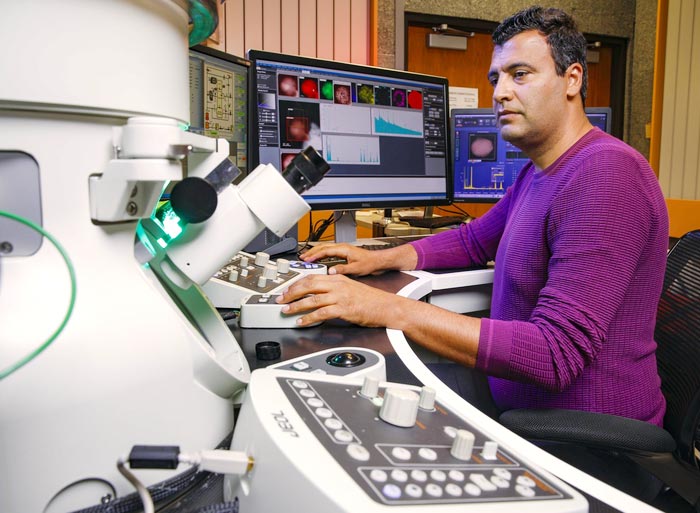Understanding how rechargeable aqueous zinc batteries work

UIC College of Engineering Professor Reza Shahbazian-Yassar with the ARM microscope.
Credit: Jim Young/UIC College of Engineering
Study debunks accepted assumptions of charging mechanism in rechargeable aqueous zinc-manganese battery cells.
While scientists have hoped that rechargeable zinc-manganese dioxide batteries could be developed into a viable alternative for grid storage applications, engineers at the University of Illinois Chicago and their colleagues identified the reasons these zinc-based fuel systems fail.
The scientists reached this conclusion after leveraging advanced electron microscopy, electrochemical experiments and theoretical calculations to look closer at how the zinc anode works with the manganese cathode in the battery system.
Their findings are reported today in Nature Sustainability.
“Zinc and manganese separately have very favorable properties for high-quality sustainable batteries; however, when paired in a full system their intercalation — their rechargeability — has been debatable, with some recent studies suggesting zinc insertion and deinsertion in manganese dioxide is responsible for the rechargeability of the cells,” said study lead author Reza Shahbazian-Yassar, UIC professor of mechanical and industrial engineering in the College of Engineering. “With this study, we showed there is actually no microscopic evidence of zinc reinsertion into manganese dioxide, and what was previously thought to be indicators of recharging was from positively charged hydrogen ions being inserted in the manganese, not zinc.”
In their experiments, the researchers built aqueous zinc-manganese dioxide cells and tested them over 100 cycles. They discharged and attempted to recharge the batteries in experiments while using electron microscopy to capture atomic-level images of the reactions.
“We saw that the hydrogen is responsible for the damage to the tunnel structures of manganese dioxide, further reducing the potential of the battery for recharging,” Shahbazian-Yassar said. “The information we’ve obtained with these experiments reveals important atomic insights into the mechanisms of the zinc-manganese battery. Now that we know what is happening at the cell level, we have a compass for finding better strategies.”
Shahbazian-Yassar said different cell structures could make the system more favorable for zinc insertion or maybe strategies to harness the hydrogen protons.
The paper, titled “Understanding intercalation chemistry for sustainable aqueous zinc-manganese dioxide batteries,” is co-authored by Yifei Yuan, Kun He, Mahmoud Tamadoni Saray, Wentao Yao and Meng Cheng from UIC; and Ryan Sharpe, Chenghang Li, Tongchao Liu, Hule Kin, Shun Wang, Khalil Amine, M. Saiful Islam and Jun Lu from partner institutions. Partner institutions include Wenzhou University, the University of Bath, Argonne National Laboratory and the University of Oxford.
Journal: Nature Sustainability
DOI: 10.1038/s41893-022-00919-3
Method of Research: Experimental study
Article Title: Understanding intercalation chemistry for sustainable aqueous zinc–manganese dioxide batteries
Article Publication Date: 8-Aug-2022
Media Contact
Jacqueline Carey
University of Illinois Chicago
jmcarey@uic.edu
Office: 312-996-8277
All latest news from the category: Power and Electrical Engineering
This topic covers issues related to energy generation, conversion, transportation and consumption and how the industry is addressing the challenge of energy efficiency in general.
innovations-report provides in-depth and informative reports and articles on subjects ranging from wind energy, fuel cell technology, solar energy, geothermal energy, petroleum, gas, nuclear engineering, alternative energy and energy efficiency to fusion, hydrogen and superconductor technologies.
Newest articles

Innovative 3D printed scaffolds offer new hope for bone healing
Researchers at the Institute for Bioengineering of Catalonia have developed novel 3D printed PLA-CaP scaffolds that promote blood vessel formation, ensuring better healing and regeneration of bone tissue. Bone is…

The surprising role of gut infection in Alzheimer’s disease
ASU- and Banner Alzheimer’s Institute-led study implicates link between a common virus and the disease, which travels from the gut to the brain and may be a target for antiviral…

Molecular gardening: New enzymes discovered for protein modification pruning
How deubiquitinases USP53 and USP54 cleave long polyubiquitin chains and how the former is linked to liver disease in children. Deubiquitinases (DUBs) are enzymes used by cells to trim protein…



